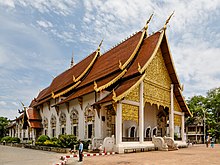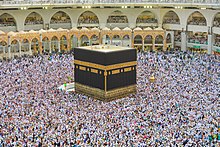Religious community

A religious community is a community (group of people) who practice the same religion. The term is used to refer to members of a religion who live within a community, but not segregated from others and not dedicated solely to their faith. They worship together in a religious venue such as a temple, synagogue, church or mosque. In many religions, a group worshipping in common is called a congregation. In a narrower sense, a religious community[1][2] is a group of people of the same religion living together specifically for religious purposes, often subject to formal commitments such as religious vows, as in a convent or a monastery.[3] Most religious communities are part of the way religions are organized, and most religions have some form of Religious order.
Christianity

Christianity has had a variety of religious groups dating back to the early church. Christian monasticism began in the Eastern churches, and eventually moved to the west.[4]
Catholicism
Religious Order
In the
Religious Congregation
A
Monasteries and convents
In the

Parish
A
Eastern Orthodoxy
Intentional communities
While not Christian in nature, an intentional community is a voluntary residential community designed to have a high degree of social cohesion. There are many secular communities, but monasteries, kibbutzim and ashrams are the religious versions.[10]
Lay religious communities are Christian examples of intentional communities. They include groups such as the
Buddhist monasteries

In Buddhism, the
Hinduism
An
Islam

In Islam, Ummah (
The Quran typically refers to the ummah as a single group that shares common religious beliefs, specifically those that are the objects of a divine plan of salvation.[18]
See also
- Full communion in Christianity
- Religious congregation
- Religious organization
- Ghetto
References
- ^ "PRH - Start-up notification of religious community". Finnish Patent and Registration Office. September 19, 2019. Retrieved June 14, 2020. One definition of the requirements to be recognized as a "religious community"
- ^ "Find a Religious Community". Diocese of Portsmoth. 2019. Retrieved June 14, 2020. Example of use of the term "Religious Community"
- ISBN 9780871910431. 79 pages.
- ^ ISBN 978-0-19-508333-0.
- ^ Ryan, George (January 9, 2018). "What Is a Religious Order? The Major Catholic Religious Orders Easily Explained". uCatholic.
- ISBN 978-8479662417.
- ^ Wooden, Cindy (July 31, 2014). "Changing needs, changing names: Reform of Curia is Vatican tradition". The Catholic Sun. The Catholic Sun. Retrieved April 13, 2017.
- ^ "The Roman Curia - Index". Vatican.
- ^ "canon 518", Code of Canon Law
- ISBN 978-0-203-83263-9. Retrieved September 20, 2021.
- ^ Ryan, John. "Hutterites". The Canadian Encyclopedia. Retrieved June 12, 2017.
- ^ Rajani, Deepika (July 25, 2019). "Inside The Bruderhof: The radical Christians living in an English village". inews.co.uk. Retrieved August 15, 2019.
- ISBN 9780300059335.
- ISBN 1-134-50165-X.
- ISBN 978-0-87481-047-9.
- ^ Gopal, Madan (1990). K. S. Gautam (ed.). India through the ages. Publication Division, Ministry of Information and Broadcasting, Government of India. p. 70.
- ^ "Rohingyas and the Myth of Ummah". Kashmir Observer. January 5, 2017. Retrieved March 30, 2021.
- ISBN 9004082654.
Further reading
- Campbell, H. (2005). Exploring Religious Community Online: We are One in the Network. Digital formations. P. Lang. ISBN 978-0-8204-7105-1.
- Hanretta, S. (2003). Constructing a Religious Community in French West Africa: The Hamawi Sufis of Yacouba Sylla. University of Wisconsin--Madison.
External links
 Media related to Religious groups at Wikimedia Commons
Media related to Religious groups at Wikimedia Commons
